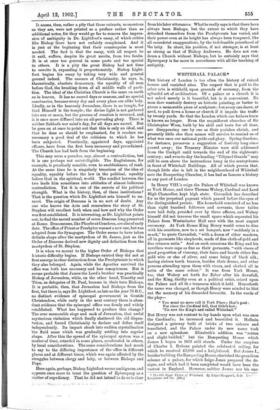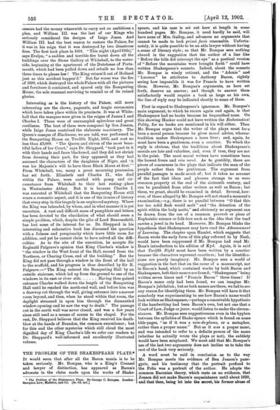WHITEHALL PALACE.*
THE history of London is too often the history of ruined houses and vanished sites. The respect that is paid to the other arts is withheld, upon grounds of economy, from the splendid art of architecture. Of a palace or a church it is not asked merely is it beautiful, but is it convenient. No man dare wantonly destroy an historic painting, or batter to pieces a memorable piece of sculpture; but every one dares, at need, to pull down a house or church if it impede the traffic by twenty yards. So that the London which our fathers knew is known no longer. Even the magnificent churches of Sir Christopher Wren, built by his skill and taste for all time, are disappearing one by one as their parishes shrink, and presently little else than names will survive to remind us of what was once our national pride and glory. Spring Gardens, for instance, preserves a suggestion of festivity long since passed away; the Treasury Minutes were still addressed from the Cockpit until towards the end of the eighteenth century.;. and even to-day the heading " Tiltyard Guards" may still be seen above the instructions hung in the sentry‘boxes in front of Whitehall Buildings. All of which proves that, though little else is, left in the neighbourhood of Whitehall save the Banqueting.Chamber, it has had as famous a history as any part of London.
In Henry VIII.'a reign the Palace of Whitehall was known as York House, and there Thomas Wolsey, Cardinal and Lord High Chancellor, kept high state. Cavendish has described for us the perpetual pageant which passed before the eyes of the distinguished prelate. His household consisted of no less than eight hundred followers and servants, three tables were laid daily, presided over by three officers, and Wolsey himself did not traverse the small space which separated his Palace from Westminster Hall save with the most august ceremony. At York House King Henry would come to dine with his courtiers, now to a set banquet, now " suddenly in a m ask,' to quote Cavendish, " with a dozen of other' maskers, all in garments like shepherds, made of fine cloth-of-gold and fine crimson satin." And on such occasions the King and his revellers wore caps as fine as their garments, " with visors of good proportion of visnomy, their hairs and beards either fine gold• wire or else of silver, and some being of black silk; having sixteen torch bearers, besides their drums, and other persons attending upon them with visors, and clothed all in satin of the same colour." It was from York House, too, that Wolsey set forth for Esher after his downfall, and the King, thrifty even at a political crisis, seized upon the Palace and all the treasures which it held. Henceforth the name was changed, as though Henry were minded to blot out the memory of his discarded favourite. In the words of the play- " You must no more call it York Place ; that's past : For since the Cardinal fell, that title's lost; 'Tis now the King's and called Whitehall."
But Henry was not content to lay hands upon what was once the Cardinal's ; he increased and beautified it. Holbein designed a gateway built of bricks of two colours and tessellated, and the Palace under its new name took on a new splendour. Elizabeth's addition was "rotten and slight-builded," but the Banqueting House which James I. began in 1619 still stands. Under the auspices of Charles I. Rubens painted the celebrated ceiling, for which he received £3,000 and a knighthood. But James I., besides building the Banqueting House, cherished the grandiose scheme of a palace, for which Inigo Jones prepared the de- signs, and which had it been completed would have been the vastest in England. However, neither James nor his SW- * Tha Old Royal Palace of Whitfltall. By Edgar Sheppard, D.D. Len Lonsmana and Co. [21i.1 cessors had the money wherewith to carry out so ambitious a plan, and William III. was the last of our Kings who seriously considered the designs of Inigo Jones. And William III. had the best reason to restore the Palace, for it was in his reign that it was destroyed by two disastrous fires. The first took place in 1691. " This night (April 10th)," says Evelyn, " a sudden and terrible fire burnt down all the buildings over the Stone Gallery at Whitehall, to the water- side, beginning at the apartment of the Dutehesse of Ports- mouth, which had been pulled down and rebuilt no less than three times to please her ! The King return'd out of Holland just as this accident happen'd." But far worse was the fire of 1698, which destroyed the whole Palace with all the pictures and furniture it contained, and spared only the Banqueting House, the sole remnant surviving to remind us of its ruined glories.
Interesting as is the history of the Palace, still more interesting are the shows, pageants, and tragic ceremonies which have taken place within its precincts. It was at White- hall that the masques were given in the reigns of James I. and Charles I. These were of unexampled splendour and great costliness. The best of them were composed by Ben Jonson, while Inigo Jones contrived the elaborate machinery. The Queen's masque of Blacknesse, we are told, was performed in the Banqueting House on Twelfth Night, 1605, and cost no less than £3,000. " The Queen and eleven of the most beau- tiful ladies of her Court," says Dr. Sheppard, " took part in it with their hands and faces blackened, and they did not shrink from dressing their part, for they appeared as they had assumed the characters of the daughters of Niger, and it was his Majestie's will to have them Black Mores at first.' " From Whitehall, too, many a great mourning procession has set forth. Elizabeth and Charles II., who died within the Palace, were carried with pomp and cir- cumstance from Whitehall to their last resting - place in Westminster Abbey. But it is because Charles I. was executed at Whitehall that the Banqueting House still wears a romantic aspect, and it is one of the ironies cf history that every step in this tragedy is an unpierced mystery. Where the King was beheaded, by whom, and in what manner it is yet uncertain. A vast and difficult mass of pamphlets and letters has been devoted to the elucidation of what should seem a simple problem, which, despite the gibe of Lord Beaconsfield, has lost none of its interest for us. Dr. Sheppard in his interesting and exhaustive book has discussed the question with a fulness and perspicacity which leave little room for addition, and yet he cannot claim to have solved all the diffi- culties. As to the site of the execution, he accepts Sir Reginald Palgrave's opinion that King Charles's window is " the window in the West front of the Hall, second from the Northern, or Charing Cross, end of the building." But the King did not pass through a window in the front of the ball to the scaffold, and his progress is thus described by Sir R. Palgrave :—" The King entered the Banqueting Hall by an outside staircase, which led up from the ground to one of the windows in its east or river side Having thus gained entrance Charles walked down the length of the Banqueting Hall until he reached the north-end wall, and before him was a doorway cut through the wall, giving entrance into a narrow room beyond, and then, when he stood within that room, the daylight streamed in upon him through the dismantled window-opening and he saw the way to death." The passage cut in the north wall was never closed, and was a few years since still used as a means of access to the chapel. For the rest, Dr. Sheppard believes that the King received his death- blow at the hands of Brandon, the common executioner ; but for this and the other mysteries which still cloud the most dignified day of King Charles's life we refer our readers to Dr. Sheppard's well-informed and excellently illustrated volume.











































 Previous page
Previous page